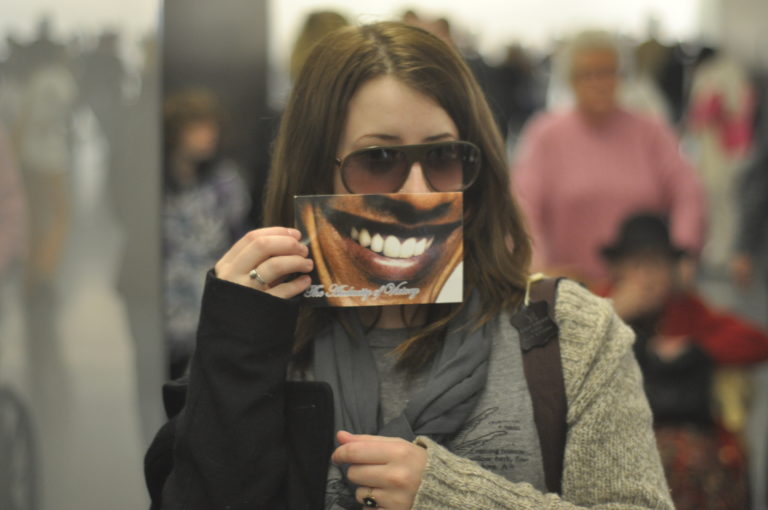
Image by David Mello.
Holding a Sacred Space of Many Silences
I am a young(ish) white woman from New York (a damned Yankee, or so I’ve been lovingly told more than once) who teaches at a diverse community college in Charleston, South Carolina. This has often been the cause of many issues in the classroom. I have been accused of being too young to teach. I have received glaring looks of judgment when I tell my students where I was raised. I have even been told by one of my students that he wanted to write a persuasive essay arguing why women shouldn’t hold positions of power over men. Yup — all this, and an adjunct salary to boot!
I often feel like an outsider (lesser, nonessential, as my job title reminds me) doing this work, which I love so much, in this place, which I have chosen to call my home. I feel this most, however, whenever I discuss issues of race and inequality in the classroom. Many of my students — of all races, ages, and backgrounds — are uncomfortable with applying critical thinking to contemporary issues. Martin Luther King Jr.’s “Letter from Birmingham City Jail” or an excerpt of Voltaire’s Treatise on Tolerance spark all kinds of interesting debates and analyses.
When I try to connect the framework of those historical arguments to contemporary issues, though, I often get a lot of push-back. On more than one occasion, my students have announced with utmost certainty that there is no such thing as inequality in our country anymore — no discrimination based on race, religion, gender, sexual orientation, you name it. Those problems were in the past. They have been resolved. The individual is limited only by his or her personal ambition and diligence. Take, for example, Tyler Perry, one student told me just this semester, “He came from the ghetto and now he has, like, millions of dollars.” How does one respond to a point like this?
How does a white Yankee outsider encourage more critical thinking than this to students in an English 101 class — some of whom don’t know who the Nazis were, or what the Jim Crow laws were — when a good portion of contemporary media often makes the very same argument?
The national discourse about race is not limited to but is certainly punctuated by a similar kind of reasoning. Barack Obama was elected president; thus, we live in a “post-racial” society. While not one of my students has ever used the term post-racial, many continue to draw on the same example of one individual narrative as proof of a larger, national one whether it be Barack Obama, Oprah Winfrey, Beyoncé Knowles.
How do I get my students to care about the stories of people whose names aren’t known or remembered? How do we broach a conversation about people who weren’t actually ever given names because they were not deemed people?

I often feel sorely underequipped in trying to respond to this kind of logic, and have been subject to that sinking feeling that the French call l’esprit de l’escalier. In other words, I come up with a fitting question or rejoinder hours or days later. This is precisely why I was so eager to sign up for “Narratives of Slavery”, a graduate class at the College of Charleston taught by a professor with way more education, experience, and expertise on the subject than I might ever hope to have. I would get answers, would be armed with facts, would know how to make history relevant in a way that would allow for my students to make their own connections, ask their own questions. In other words, I had absurdly high hopes.
On the first day of class, I was absolutely floored when the teacher, the man with a PhD and a plan, told the class that we would all have to be kind to one another throughout the semester because this was, after all, a sensitive topic, and we all were sure to say something that would offend someone at least once. Of everything we covered over the course of four months, this may have been by far the most valuable lesson. There is no answer; there is no way to deal with this kind of historical reckoning without an abundance of compassion, patience, and respect.
In order to do this work — to even begin to think about attempting this work — one must acknowledge that this will be a practice of many failures. In order to give voice to the transatlantic slave trade, its long life, and its innumerable repercussions, one must embrace a silence created by two factors: a silence necessary for listening, and a silence necessary to acknowledge that which is unspeakable.
And there’s the rub. Who can afford silence in our contemporary Western culture?
It is no small victory to me when an entire class passes by without a student fiddling around on his cell phone. Devices and social media have given us all an endless supply of data to fill up awkward, uncomfortable silences. In her TED talk, “Connected, but Alone?”, Sherry Turkle says that even mere moments at a stop light become a time to reach for the phone because we are becoming conditioned to fear our own contemplation, fear what might come up during those stretches of silence.
When I have played this speech in class, students nod in recognition of this anxiety. They share stories about pretending to be on the phone while walking down the street so they don’t have to make eye contact with another person. The classroom, which always features at least one person making direct eye contact and leaving room in the conversation for thoughtful reflection, must seem like a nightmare to this new kind of citizen. Add to that level of discomfort the expectation of addressing painful realities about both the past and the present, and it’s no wonder my students want to wash their hands of the whole messy affair. On the other hand, though, this sacred space of silence, of eye contact, of respectful debate is just the place where the necessary conversation about social and legal inequalities must begin.
Lucky for me, teaching in Charleston, South Carolina affords so many opportunities to explore exactly what these silences look and feel like. Local billboards, tours, and media present a narrative about this particular time and place that conveys all the charms of Southern living. This is the story for people with money to spend. This is the story of mostly white tourism. Story number one: Magnolia Gardens, Husk, Rainbow Row, Battery Park, jambalaya, mint juleps, Spanish moss, seersucker suits.
Then, there is another story, one I know all too well, precisely because I am an outsider. This is the story that non-Southerners — specifically those who are raised in the Northeast — tell to assuage any lingering guilt about this country’s horrifying enslavement and subjugation of so many black people. Story number two can be summed up with two sounds, as it is so potent and popular that it has been condensed to its mere essence: a few chords of “Dueling Banjos” from the 1972 film Deliverance, and the slow, throaty, elitist drawl of a long vowel (my personal favorite is any impersonation that John Stewart does of Lindsey Graham on The Daily Show). These sounds represent Southern ignorance, racism, and ineptitude.
Of course, one can’t help but see that this kind of “othering” must also fall upon the largely black populations that still reside in the South — in places like Jackson, Mississippi; Birmingham, Alabama; Atlanta, Georgia; and, yes, Chaaawlston, South Carolina. Most of my family and friends from the North — basically good people, mostly liberal, with varying degrees of experience in higher education — routinely crack jokes about the South to me, a person who has chosen to make her home in the South for the last 11 years.
I usually point out that the towns they live in are lily white and/or marked by severe class segregation. This doesn’t always go over well. They are mostly too entrenched in the national discourse about racism, which casts a long shadow over the South, to see their own complicity. It’s an equation that works for them: North equals progressive; South equals intolerant.
Surely, though, there are many more stories to be told by and about the South, about the people who have called or currently call this place home. The search for these stories is a quest to give voice to the silent and, at the same time, a quest to eclipse those narratives that have dominated the discourse for so long.

Before reading works like Caryl Phillips’s The Atlantic Sound, I Belong to South Carolina: South Carolina Slave Narratives edited by Susanna Ashton, and Lawrence Hill’s Someone Knows My Name, I had lived and taught in Charleston for five years without ever once hearing about Judge Waties Waring, the Sugar House, or the Sullivan’s Island “pest houses.” When I really think about this reality, I have to humbly reserve a lot of judgement I pass on my students (and family and friends) when I am condescendingly told, as if I were a 34-year-old insisting on her belief in Santa Claus, that racism does not exist.
I must be kind to those around me, for everyone is not only fighting a hard battle but is also coming out of that battle with their own stories — about themselves, about their culture, about their world. I must be kind because they will surely say something that offends me, and I, in turn, will surely say something equally as offensive to them one day, probably tomorrow.
I must work to hold a sacred space of many silences within the classroom. I must seek out and share forgotten stories, ugly stories, triumphant stories. I must ask difficult questions, both of myself and of others. Most importantly, though, I must not be afraid to fail because sometimes simply asking questions and allowing for silence is the beginning of real change.
If history is the story that we tell ourselves so that we can know who we are, who do we collectively become when that story does not reflect reality? What happens when — to paraphrase one of my favorite outsiders on the inside, a man of many contradictions — these narratives no longer contain multitudes but resonate instead with one hollow image, one sound-bite as punch-line, one name?

